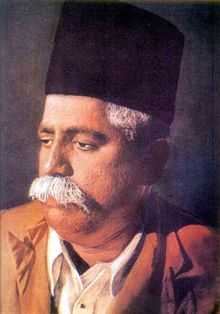1927 Nagpur riots
The Nagpur riots of 1927 were part of series of riots taking place across various cities in British India during the 1920s. Nagpur was then the capital of Central Provinces and Berar (CP&B) state of British India which covered most of the central India. The riots occurred on September 4, 1927.[1] It was the day of Lakshmi Puja – a Hindu festival day during Diwali.[2] Nagpur had earlier experienced similar riots between Hindus and Muslims in 1923.
Background

The mutual distrust between Hindu and Muslim communities in 1920s had reached low and riots were seen frequently across many cities of India. In 1923, India witnessed eleven riots, in 1924 there were eighteen riots, in 1925 there were sixteen riots, and in 1926 there were thirty five riots.[3] I n the twelve months from May 1926 to April 1926, 40 more riots occurred across various cities. These mostly occurred in Bengal, Punjab and United Provinces (UP). Lahore riots of August 1927 were the most deadly recorded riots in this series.[1]
The earlier riot of 1923 was caused when members of Hindu Mahasabha took out a procession and passed in front of a mosque and played loud music. The Muslim community objected starting a skirmish between the two parties.[3] These riots had a profound impact on K. B. Hedgewar, prompting him to form Rashtriya Swayamsevak Sangh (RSS), a Hindu nationalist organization and currently one of largest Hindu organization in world, at Nagpur in 1925.[4] Jacques Généreux in his book The Hindu Nationalist Movement and Indian Politics records a testimony saying that Hedgewar led the Ganesha procession in 1927, beating the drums in defiance of the usual practice not to pass in front of the mosque with music.[5] All these events acted as catalyst building up the tension between two communities.
Riots
On the morning of September 4, day of Laksmi Puja, Hindus took out a procession like every year and passed in front of a mosque in Mahal area of Nagpur. However, the Muslims this time stopped the procession and did not allow it to pass from the area. In the afternoon, when the Hindus were resting after morning procession, Muslim youths took out a procession shouting Allahu Akbar and were armed with weapons.[2] They carried weapons like javelins, daggers and knives.
Muslim youths threw stones at house of Hedgewar, who was then out of Nagpur.[6] RSS cadres sensing the mood of the procession came out in the narrow lanes of Mahal area and reciprocated with lathis further intensifying the riots.[2] Liaquat Ali Khan in his book Pakistan — The Heart of Asia also describes a major arson incident during the riot that seemed pre-meditated with explosives gathered well before the riots began.[1]
The Washington Post reported 22 had been killed and more than 100 injured in riots that continued for two days.[7]
Later, the government ordered troops into the city to restore peace.[8] During the riots, RSS had grouped its cadres in 16 shakhas and spread across the city to protect Hindu communities.[9]
Aftermath
RSS had showcased its role in defending Hindus during the 1927 riots.[10] The popularity of organization ushered as the news of this incident spread across the country, and it saw a spurt in the membership, further strengthening RSS.[6][11] By 1929, an organization took elaborate hierarchical structure and between 1931–1939 the number of its branches grew from 60 to 500. The membership count had reached 60,000 by this time.[9]
References
- ↑ 1.0 1.1 1.2 Pakistan — The Heart of Asia. READ BOOKS. 2007. pp. 157–159. ISBN 978-1-4067-4352-4.
- ↑ 2.0 2.1 2.2 Rashtriya Swayamsevak Sangh. APH Publishing. 2004. pp. 249–250. ISBN 978-81-7648-465-7.
- ↑ 3.0 3.1 Gandhi in His Time and Ours. Orient Blackswan. 2003. pp. 165–166. ISBN 978-81-7824-114-2.
- ↑ Lineages of the Present. Verso. 2002. p. 291. ISBN 978-1-85984-765-7.
- ↑ The Hindu Nationalist Movement and Indian Politics. C. Hurst & Co. Publishers. 1996. p. 40. ISBN 978-1-85065-301-1.
- ↑ 6.0 6.1 Khaki Shorts and Saffron Flags. Orient Blackswan. 1993. pp. 19–20. ISBN 978-0-86311-383-3.
- ↑ "HINDU-MOSLEM RIOTS RESULT IN 22 KILLED". The Washington Post (1877–1954). Sep 8, 1927. Retrieved 2009-01-10.
- ↑ "25 DEAD, 180 INJURED IN CREED RIOTS IN INDIA; Troops Are Called to Quell TwoDay Hindu-Moslem Fight at Nagpur.". New York Times. September 8, 1927. Retrieved 2009-01-10.
- ↑ 9.0 9.1 Marty, Martin E.; Appleby, F. Scott; Appleby, R. Scott (1991). Fundamentalisms and the State. American Academy of Arts and Sciences. University of Chicago Press. p. 241. ISBN 978-0-226-50884-9.
- ↑ Ayres, Alyssa; Oldenburg, Philip (2005). India Briefing. M.E. Sharpe. pp. 118–119. ISBN 978-0-7656-1593-0.
- ↑ Religion, Power & Violence. SAGE. 2005. p. 132. ISBN 978-0-7619-3338-0.
| ||||||||||||||||||||||||||